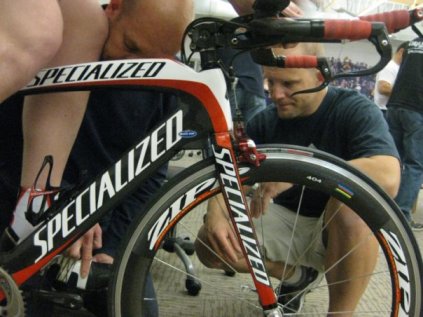HOW DO I KNOW?
Several of the signs are pretty obvious: persistent knee pain being the most common. But there are a few quick and easy signs that something is wrong that aren’t immediately apparent (or that some of you think you just have to live with). Let’s start at the front of the bike and work our way back.
-Numb hands: Bike fitting can’t always eliminate this issue as sometimes there are some deeper things going on (poor circulation being an obvious one). But, often this is a marker that something is wrong with your position and your hands are having to do too much of the work of supporting your torso.
-Can’t comfortably use all or most of your handlebar: I see this one pretty often. You paid for all of that handlebar, you might as well be able to use all of it that is possible! All kinds of position errors can limit your access to your handlebar. If you’re not able to reach all the different positions on the bar, you’re not getting the most out of your bike and not able to change positions enough to enhance your comfort.
-Poor handling characteristics or difficulty descending: There can be many causes to these symptoms ranging from the mechanical to the psychological. But, a correct position on the bike is not only comfortable, but lets the bike work as it is designed because the rider’s weight is distributed properly. Handlebar position, stem length, and saddle position can all contribute to fit related causes.
-Locked elbows: Usually mean your handlebar is in the wrong spot. This makes your bike handle less predictably and often causes soreness in the elbows, shoulders, neck, and possibly elsewhere. Your bar could be wrong in any direction though: High, low, too close or too far; so consult a pro.
-Sore neck or headaches after riding: Often also an indication of poor handlebar position requiring the rider to hold the head up too far or driving the shoulder blades together.
-Muscular soreness or fatigue at shoulder blades: Often indicates a handlebar that is too wide, thereby forcing these muscles, instead of skeletal structure; to do too much of the job of supporting your torso.
-Lower back pain, soreness, fatigue: Can be poor handlebar position or saddle position causing strain on the muscles or vertebrae.
-Sore hip(s): On one side? Usually an alignment issue between the hips and feet. Can be saddle or shoe and pedal related Both sides? Poor seat or clipless cleat position. This can definitely be something deeper as well.
-Persistent symmetrical seat discomfort: Improper seat position (usually too high) is the most common cause of this symptom that I encounter. This causes too much of your weight to be supported on the saddle rather than being shared on your feet and hands. Poor saddle choice for your anatomy, riding position, or riding habits is also a cause.
-Asymmetrical seat discomfort/saddle sores: Often caused by a misalignment between the hips and feet causing the rider to not sit squarely on the saddle. Improper saddle choice can also cause the issue due to a rider’s tendency to attempt to adapt thereby creating a misalignment.
-Frequent Hamstring/Quadriceps cramping: Seat position usually not optimal for your physiology and/or riding style and strengths. Can also be nutrition related. Examine your nutrition first as it is usually easier to solve (and a good thing to pay attention to anyway…)
-Knee pain: Dr. Andy Pruitt could write a whole book on this (wait, he practically did!). This is a complicated issue. If it is persistent, see a trained, experienced, respected fitter.
-Calf (Gastrocnemious) cramping: Often poor seat or cleat positioning or nutrition as above.
-Ankle pain or soreness: Usually because cleat alignment, rotation, or angular orientation is not bio-mechanically correct for you.
-Foot pain, numbness, discomfort: Often due to lack of proper support in the shoe, improper cleat positioning, or poor shoe fit. Can also be the result of other physiological issues such as poor circulation or nerve issues.
This is of course, not a complete listing and only meant to serve as a point to begin a conversation with a fitter – be it myself or another experienced, trained professional. If fitting has not helped or solved your problems, definitely consult a physician. But, if any of these experiences are familiar to you; it might be a good time to seek out someone to help you get more enjoyment from your riding.
I’ll do my best to address comments on this one; but some riders’ issues require a different medium of communication than this allows. I may refer you to a fitter in your area.
Thanks for reading!
